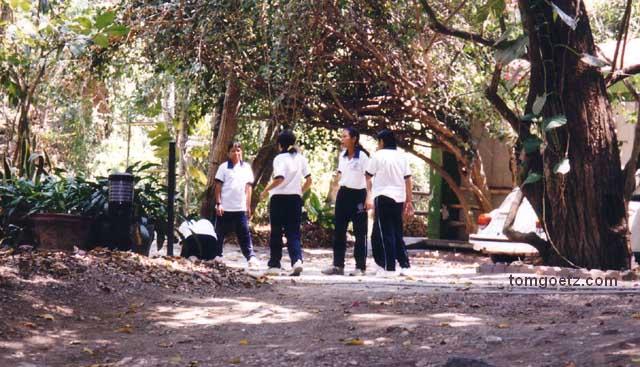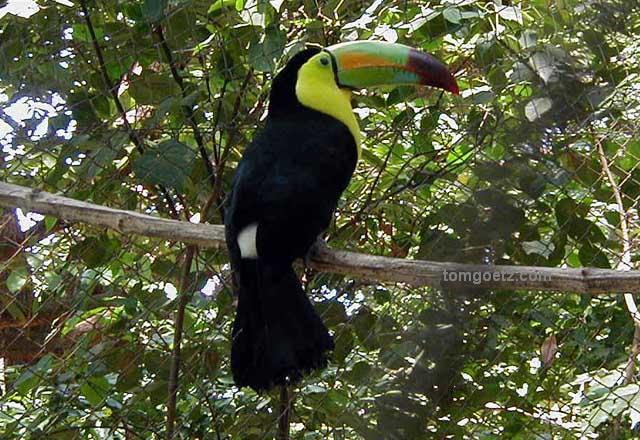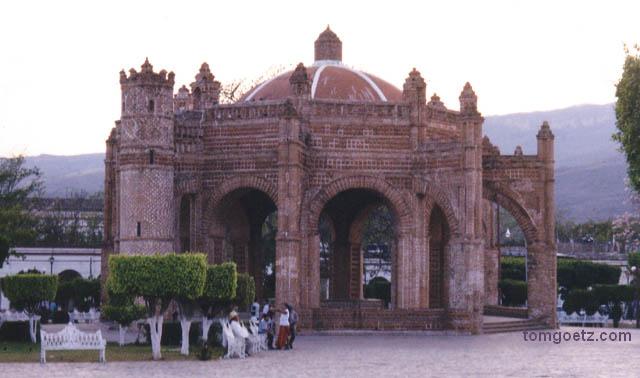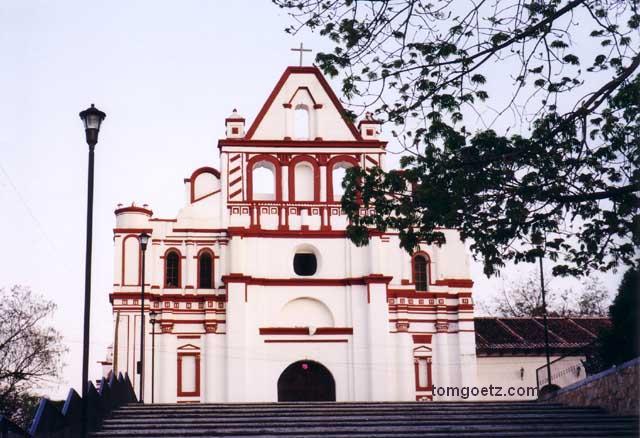Friday, February 28, 2003
We day-tripped to Tuxtla Gutiérrez today,
population around 500,000. A local bus from Chiapa to
Tuxtla dropped us at that company's station, then we
walked six blocks through the teeming streets to the
colectivo stop for the zoo, our destination. The
colectivo was an experience. No matter how full it
was, people kept getting in. And the driver was going
FAST. There were so many people crammed in the
minivan that Tom couldn't see out at all, and I
barely could. The colectivos make frequent stops, and
we didn't know exactly where we were going. But the
zoo was the only stop listed on the windshield of the
van, so we figured we'd either see it or we'd get off
at the end.
When the bulk of the passengers disembarked at the
end of the line, we did too, where we found ourselves
at (dramatic pause) a Mexican prison! Oops. From the
great amount of activity, it appeared to be visiting
day, but since we didn't know any prisoners, we
quickly took off in the opposite direction of the
prison on foot. It seems we'd overshot the zoo by
about half a kilometer.
We arrived at the almost-deserted zoo and were
told by a guard we'd have to wait 45 minutes to go
in. At this time it appears you're only allowed to
visit the zoo with a guide, and they do three tours a
day. Waiting along with us was a group of teenage
girls from a Catholic girls' school on a field trip.
I was fully prepared to give them the evil eye if
they started flirting with my husband, but they
behaved.

Catholic schoolgirls
The Zoomat, also called Zoológico Miguel Alvarez
del Toro, is really something special. The
interesting thing about the park is that every one of
the several hundred animals there is native to the
state of Chiapas. Among others, we saw crocodiles,
spider monkeys and howler monkeys, tamandras
(sloth-like animals), nutrias (otter), tigrillos,
leoncilles, huge black jaguars, peccaries (wild
pigs), tucans, owls, and quetzales (a rare bird).
Several species of non-dangerous animals are allowed
to run free, and we'd see them scurrying past as we
walked along the paths. Our tour of the zoo lasted a
little over an hour and consisted of only the guide,
Tom and me, and one other couple. The cost for this
was absolutely nothing.

Tucan cuello amarillo (Yellow-necked toucan)
We took a taxi back to centro to avoid any more
unexpected adventure and ate a late lunch at La
Sombrita, a little antojito (literally translated
"something you eat on a whim") stand in the plaza.
We'd seen the prison, the plaza, and the zoo in
Tuxtla. How could we top that? So we walked back to
the bus station, returned to Chiapa de Corzo,
rehydrated with a few liters of water and juice, and
took cold showers. It is over 100 degrees.
The Zócalo in Chiapa isn't quite as happening as
the other towns we've been in. I suspect it's just
too damn hot. Dominating the square is Chiapa's most
remarkable monument, a great brick monstrosity built
in 1562. It is supposedly the finest example of
mudéjar, or Hispano-Moorish, architecture in the
Americas. The structure is actually a giant canopy
over a well-head, called a Pila. Just like I've
always said: Anything worth doing is worth doing to
excess!

The Pila
Across from the square, before you come to the
river, is the town's other great monument, the church
and former monastery of Santa Domingo, built in the
late 16th century.

Santa Domingo
Tonight we had the best meal of our trip, at El
Campanario, a block from the plaza, a restaurant
sharing the same owners as the overpriced Hotel la
Ceiba. It was fabulous. The meal was about twice what
we've paid elsewhere and well worth it. Tom had a
sirloin and I had carne de Tampiqueña. Along with two
cervezas each, the meal set us back 216 pesos, less
than 20 bucks.
Out on the street, someone was setting off big
homemade fireworks for no apparent reason - loud, but
not particularly impressive.
|



